How is a ceramic chimney constructed: the specifics of installing a ceramic chimney
Ceramic chimney is the undisputed leader among smoke removal systems. This is a modern and reliable device with which you can effectively organize the operation of your heating device.
Installation of such a chimney is not too complicated, although it is better for inexperienced builders to seek the advice of a good master.
In this material we will talk about the features of ceramic chimneys, as well as provide step-by-step instructions for their independent installation.
The content of the article:
Features of ceramic designs
The use of ceramic components for the installation of the chimney is a brilliant solution in its own way. Burnt clay is resistant to almost any temperature, so these chimneys can be used for boilers running on liquid or solid fuel.
This feature of the material makes it versatile in application. Especially for low-temperature boilers, a separate version of such a chimney has been developed.
Burnt clay tolerates sudden temperature changes with amazing resistance, the life of such a chimney reaches three decades. One of the main advantages of ceramics is a high level of fire safety. On the smooth walls of the structure, a minimal amount of soot and other foreign products accumulates, which significantly reduces the risk of fire.
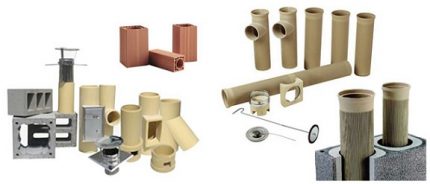
The ceramic walls of the chimney perfectly retain heat and resist the effects of moisture condensed on the walls, even if this moisture contains acids or other corrosive substances.
With proper installation, combustion products never enter the room through random slots. The smoke is removed completely and with a high degree of efficiency.
Ceramics not only interferes with the transfer of heat to the surrounding objects, but also accumulate part of the thermal energy. Such structures can be installed both inside the building and outside. In the latter case, it is necessary to take care of additional insulation of the structure.
Private housing is almost the only area of application for ceramic chimney systems. They cannot be installed in multi-storey buildings.
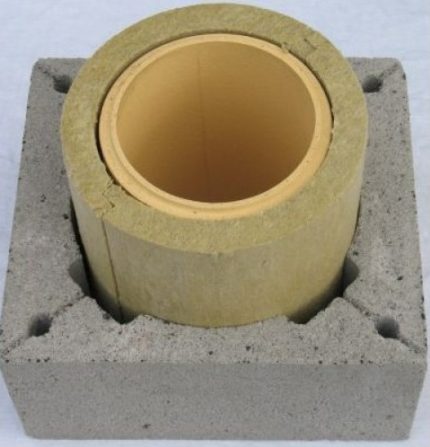
It is worth remembering that such devices are quite expensive in comparison with their analogues. Another problem that can arise with a ceramic chimney is the ban on bends. Ceramic chimney should be installed strictly upright. If this is not possible, then you will have to give preference to another type of chimney.
Ceramic chimney construction weighs a lot. That is why, if the weight of the chimney exceeds 400 kg, you will have to install a separate foundation for it, which should not be connected with the general foundation of the structure. However, on monolithic foundations, such installation is allowed, but nevertheless, it is necessary to correlate the increased load with the total bearing capacity of the foundation.
If you plan to install a ceramic chimney not on the first floor, but higher, you need to calculate the load and compare with the bearing capacity of the ceiling.
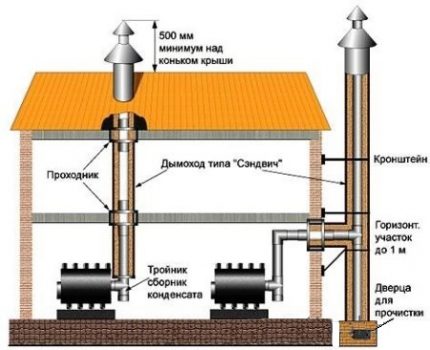
Installing a ceramic structure looks relatively simple, but still it requires effort and a very careful attitude. If the steel structure can be assembled in just one day, then for the installation of ceramics of the same length it will take two or three days.
In addition, such a chimney cannot be dismantled and installed in a new place, but steel systems are suitable for reuse.
Device and regulatory requirements
Chimneys of this type consist of individual blocks, which are assembled as a designer. A special heat-insulating layer is mounted on top of the ceramics, all this is enclosed in a lightweight concrete frame.
In addition to the main blocks for the installation of such a design, other elements are necessary, without which no chimney can do:
- chimney base;
- tee for inspection and cleaning of the structure;
- adapter for connecting a heating device;
- condensation trap.
The chimney must be high enough to create good draft. The optimum is considered a height of five meters or higher. Even if the pipe turns out to be much larger, you should not worry about excessive increase in traction.At high altitude, the gases that travel through the pipe have cooled slightly, and this will increase their weight, and the speed will slow down.
A ceramic chimney must rise at least 50 cm above the roof ridge or its parapet. To accurately determine the maximum length of the pipe protruding above the roof, a conditional straight line is drawn from its ridge at an angle of 10 degrees down from the horizontal guide.
The chimney must be above this conditional level. If the pipe goes onto a flat roof, it should rise 120 cm.
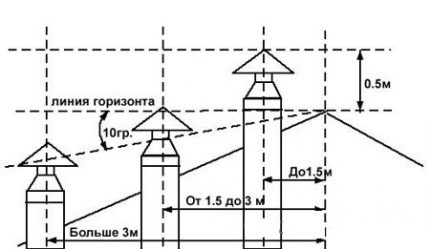
With regard to the adapter that connects the chimney and the heating boiler, it should be remembered that its diameter must be the same as the size of the chimney or larger. Narrowing the structure at the connection point is unacceptable.
When installing a condensate tank, remember that a siphon of about 15 cm long is needed to create a ten-centimeter water shutter.
Chimney installation procedure
High fire safety of ceramic chimneys allows their successful use in buildings made of natural wood. In this case, it is necessary to reckon with the possibility of shrinkage of the structure. Therefore, in such buildings, for example, in residential buildings or saunas, it is not necessary to rigidly fix the chimney to the roof or ceilings.

If the fastening is rigid, it can cause damage to the chimney structure in the future. When installing any chimneys, the manufacturer's recommendation should be followed, but special attention is paid to compliance with fire safety rules.
During the installation process, you will have to perform the following steps:
- Conduct a series of preparatory activities.
- Install the base under the chimney.
- Install an adapter to connect to the boiler and a tee to service the structure.
- Mount the chimney.
- Cover the structure with insulating materials.
- Fasten and decorate the outer part of the chimney.
Exact observance of ceramic chimney mounting technology will make them reliable, safe and resistant to extraneous influences. But negligence and blemishes can lead not only to damage to the structure, but also to the occurrence of a fire.
The optimal time for installation of the chimney structure is before the start of decorative decoration of residential premises, as well as before the laying of the roofing cake is completed.
Preparation and installation of the base
Before starting work, you need to purchase all the necessary elements and materials. To do this, it is necessary to calculate the length of the chimney according to the above rules, as well as determine the parameters of the base structure.
The connection between the boiler nozzle and the adapter must match exactly. If this point is not thought out, you may need to completely redo all the work in the future.
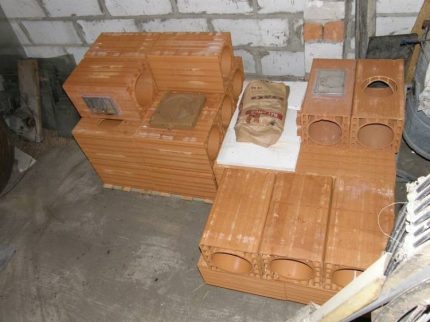
Confusion in the calculations can occur when the final floor at the installation site of the boiler has not yet been laid. When calculating the height of connecting the boiler to the chimney, it is necessary to accurately determine the height of the so-called “floor cake” in order to take these data into account when determining the height of the base for the chimney.
The base for the chimney is made of a cement-sand mixture, on which an adapter is installed to connect a heating device. This element has a groove through which condensed moisture will subsequently be removed. Attention must be paid to this point so as not to damage an important component during installation.
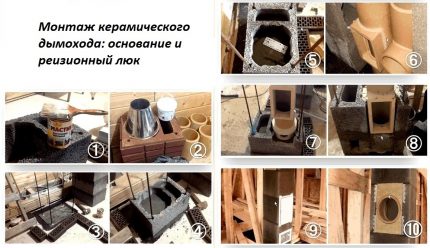
The position of the adapter must be strictly verified horizontally using the construction level. In addition to the condensate tank at the bottom, there is also a supply air grille through which the structure is ventilated.
The foundation for a ceramic chimney is done in much the same way as any other foundation. It is poured with concrete, on top you need to cover the structure with a layer of waterproofing, for example, roofing material.
Tee and pipe installation
For further installation of the ceramic elements of the chimney you will need a special solution that is resistant to acid. It is prepared from a special dry mixture, which is mixed with water in a ratio of 7: 1 and thoroughly mixed until smooth. The solution should be used within one and a half hours, no more.
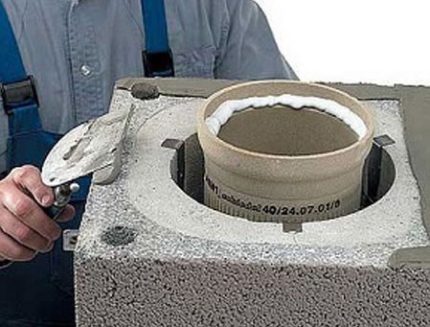
Adding water to an already prepared mixture is strictly prohibited. The tee, designed to service the structure, is installed on the connection pipe to the boiler, carefully lubricated at the junction with this solution. Next, the remaining elements of the chimney are sequentially installed on the tee.
The lower part of the next element is always inserted into the upper part of the previous structural part. All joints are sequentially coated with a solution. Excess bonding agent is carefully removed with a damp sponge. During installation work, the position of the structure is constantly checked using a plumb line.

An important point of fire safety during the installation of the chimney is the position of the joints of the individual elements. It is highly undesirable for the junction to be in the thickness of the ceiling. Unfortunately, avoiding this arrangement is not always possible. In this situation, additional measures will be required to prevent a possible fire.
The junction of the ceramic elements of the chimney, which falls into the ceiling, should be additionally hidden using non-combustible materials. Particular attention is required and that part of the chimney, which is laid through the attic. If there is no heating in this room, it is necessary to additionally insulate this section of the chimney pipe.
Insulation and concrete blocks
Special thermowells made of heat-insulating and fire-resistant material are intended for thermal insulation of the ceramic structure. Sheathing should be installed in parallel with the installation of ceramic elements. Parts of the material are joined using sealant.
For its application, it is most convenient to use a special gun. The sealing composition is applied both to the edges of the insulating material and to the upper edge of the ceramic element. As installed, excess sealant will protrude from the outside. It is best to remove them until the sealant has completely solidified.
For additional insulation of a ceramic chimney, cement-bonded boards, fire-resistant drywall boards, etc. can be used. It is important to consider the features of the room in which the structure is located.
For example, some materials, such as the already mentioned fire-resistant drywall or glass magnesite, can produce substances hazardous to humans when heated. The use of such materials is not recommended in saunas, steam rooms and other similar rooms.
Lightweight concrete blocks are installed on top of the ceramic core with a sleeve of insulation. Lightweight concrete, in which a ceramic pipe with a sleeve made of insulation is enclosed, needs additional reinforcement.
It is performed using metal rods, which are inserted into special holes inside the blocks and poured with liquid cement mortar.
The holes for the fittings are made in such a way that not one but two rods are placed inside. One of them should protrude from the block by at least 100 mm.
This protruding part is mounted in the next block, such overlap can significantly increase the strength of the structure. Before installing the ceramic chimney, the rods are cut into pieces of 150 cm and inserted as necessary.
Fixing and decorating the outside
The outer part of the ceramic chimney pipe should be reinforced, especially if the structure rises above the roof by more than one and a half meters. Some manufacturers of such chimneys supply special rods, under which openings are provided in the construction, as already mentioned.
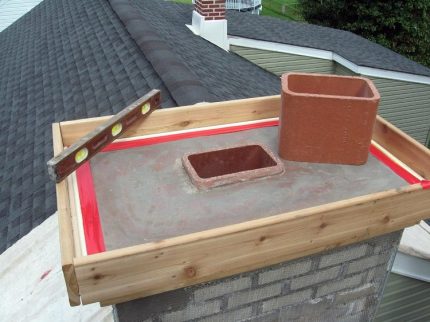
The rods are simply inserted into these holes and poured with a liquid solution. If such rods are missing or not possible to purchase, you can use a 10 mm steel bar for the same purpose.
In this case, it is necessary to observe the quality of pouring the solution so that there are no voids inside the holes.
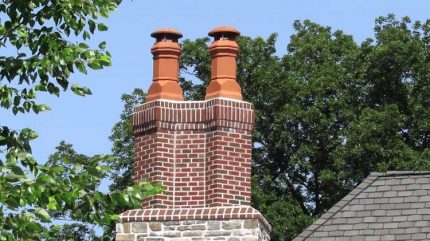
As an alternative, external reinforcement is used. To do this, you need to make a welded “case” for the chimney from a steel corner and tape. Finally, reinforcement with reinforced concrete can be carried out.
The outer part of the pipe must not only be strengthened, but also insulated. To decorate a chimney pipe that rises above the roof, you can use any non-combustible materials: brickwork or its imitation, tiles, slate, etc.
Useful installation tips
One of the main rules for installing ceramic chimneys: only whole elements are suitable for installation. The presence of chips, cracks or any other damage is unacceptable.Do not try to close up the damaged place with sealant or something like that.
This is a dangerous decision, since damage hidden inside the structure can fail at any time and cause a fire.
Therefore, each item must be checked at the time of purchase, as well as immediately before installation. If even slight damage is found, a replacement should be made. The base under the adapter should be perfectly flat and horizontal.
To achieve this, experienced builders use a level, and the surface of the base is finished with some even material, for example, tiles, porcelain tiles, etc.
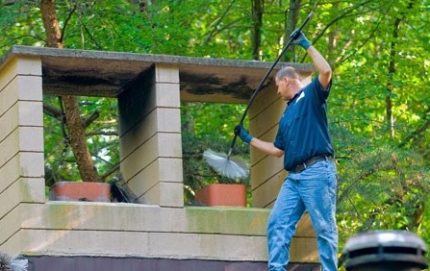
Maintenance of chimneys of this type is not difficult to perform. Need to check for traction, clean soot pipes, control the integrity of all structural elements.
Typically, these operations are performed twice a year, but if there is reason to doubt the normal functioning of the chimney, maintenance measures can be performed unscheduled. Although with proper installation, problems with such structures practically do not arise.
Conclusions and useful video on the topic
This video demonstrates the process of installing a ceramic chimney: from unpacking the factory kit to decorating the exterior:
If you need a ready-made design install gate, this master class will help to correctly perform all operations:
Here is a detailed video installation manual from the manufacturer of TONA Tec Iso systems (Germany):
The quality and reliability of ceramic chimneys explain the growing popularity of this type of structure. However, do not forget that each stage of installation of such a system must be performed correctly and as carefully as possible.
It is better for beginner amateur stove-makers to delegate this important task to specialists so as not to spoil expensive components and not endanger their home.
Want to talk about how to independently install a ceramic chimney in your own house? You can do this by leaving a comment in the box below. There you can ask questions of interest on the topic of the article.

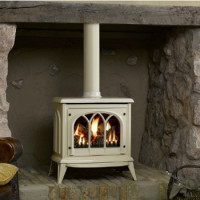 How to make a chimney for a fireplace: the rules of the device of the smoke channel and a comparison of designs
How to make a chimney for a fireplace: the rules of the device of the smoke channel and a comparison of designs 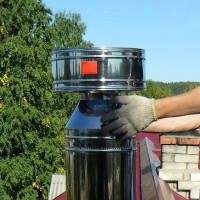 Gas boiler chimney deflector: installation requirements and installation rules
Gas boiler chimney deflector: installation requirements and installation rules  How to make a chimney in a private house with your own hands: design options and their implementation
How to make a chimney in a private house with your own hands: design options and their implementation  How to make the right chimney for a do-it-yourself stove: a step-by-step instruction
How to make the right chimney for a do-it-yourself stove: a step-by-step instruction 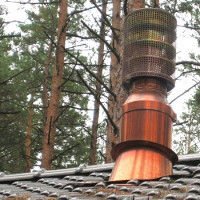 How to make a spark arrestor on a chimney with your own hands: a step-by-step guide
How to make a spark arrestor on a chimney with your own hands: a step-by-step guide 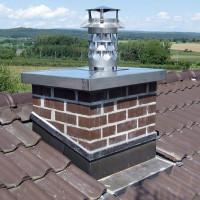 How to put a deflector on a chimney with your own hands: step-by-step instruction
How to put a deflector on a chimney with your own hands: step-by-step instruction  How much does it cost to connect gas to a private house: the price of organizing gas supply
How much does it cost to connect gas to a private house: the price of organizing gas supply  The best washing machines with dryer: model rating and customer tips
The best washing machines with dryer: model rating and customer tips  What is the color temperature of light and the nuances of choosing the temperature of the lamps to suit your needs
What is the color temperature of light and the nuances of choosing the temperature of the lamps to suit your needs  Replacement of a geyser in an apartment: replacement paperwork + basic norms and requirements
Replacement of a geyser in an apartment: replacement paperwork + basic norms and requirements
I liked the idea of a ceramic chimney. Firstly, it is perfect for any heating system, secondly, nobody canceled the corrosion resistance, thirdly, to install it yourself, you don’t need to have any special equipment and you can handle it yourself. Also, ceramics accumulate heat, which means that it will cool more slowly. But, of course, there are also disadvantages of such a chimney. Ceramics is a brittle material, it dropped everything, and a very heavy construction comes out. There is no such universal material, everyone has its pros and cons.
Yes, still fragile. I used to think that this is an exaggeration, yet the chimney is not ceramic dishes. But in the end, when they brought it right away, it turned out that a piece was chipped from one pipe (they changed it well), and after some time soot ignited and the whole pipe went cracked.